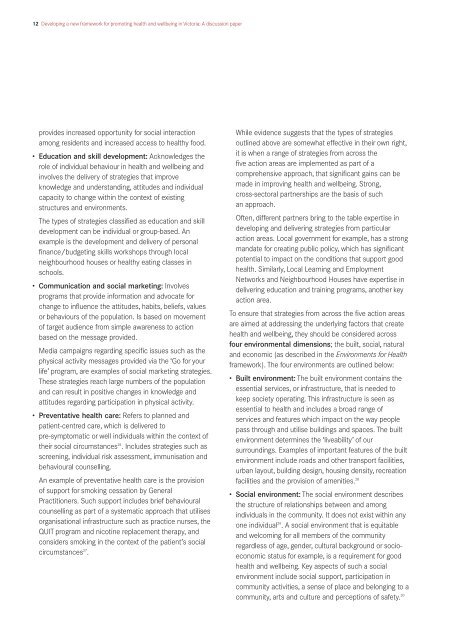Developing a new framework for promoting health and wellbeing in ...
Developing a new framework for promoting health and wellbeing in ...
Developing a new framework for promoting health and wellbeing in ...
You also want an ePaper? Increase the reach of your titles
YUMPU automatically turns print PDFs into web optimized ePapers that Google loves.
12 <strong>Develop<strong>in</strong>g</strong> a <strong>new</strong> <strong>framework</strong> <strong>for</strong> <strong>promot<strong>in</strong>g</strong> <strong>health</strong> <strong>and</strong> <strong>wellbe<strong>in</strong>g</strong> <strong>in</strong> Victoria: A discussion paper<br />
provides <strong>in</strong>creased opportunity <strong>for</strong> social <strong>in</strong>teraction<br />
among residents <strong>and</strong> <strong>in</strong>creased access to <strong>health</strong>y food.<br />
• Education <strong>and</strong> skill development: Acknowledges the<br />
role of <strong>in</strong>dividual behaviour <strong>in</strong> <strong>health</strong> <strong>and</strong> <strong>wellbe<strong>in</strong>g</strong> <strong>and</strong><br />
<strong>in</strong>volves the delivery of strategies that improve<br />
knowledge <strong>and</strong> underst<strong>and</strong><strong>in</strong>g, attitudes <strong>and</strong> <strong>in</strong>dividual<br />
capacity to change with<strong>in</strong> the context of exist<strong>in</strong>g<br />
structures <strong>and</strong> environments.<br />
The types of strategies classified as education <strong>and</strong> skill<br />
development can be <strong>in</strong>dividual or group-based. An<br />
example is the development <strong>and</strong> delivery of personal<br />
f<strong>in</strong>ance/budget<strong>in</strong>g skills workshops through local<br />
neighbourhood houses or <strong>health</strong>y eat<strong>in</strong>g classes <strong>in</strong><br />
schools.<br />
• Communication <strong>and</strong> social market<strong>in</strong>g: Involves<br />
programs that provide <strong>in</strong><strong>for</strong>mation <strong>and</strong> advocate <strong>for</strong><br />
change to <strong>in</strong>fluence the attitudes, habits, beliefs, values<br />
or behaviours of the population. Is based on movement<br />
of target audience from simple awareness to action<br />
based on the message provided.<br />
Media campaigns regard<strong>in</strong>g specific issues such as the<br />
physical activity messages provided via the ‘Go <strong>for</strong> your<br />
life’ program, are examples of social market<strong>in</strong>g strategies.<br />
These strategies reach large numbers of the population<br />
<strong>and</strong> can result <strong>in</strong> positive changes <strong>in</strong> knowledge <strong>and</strong><br />
attitudes regard<strong>in</strong>g participation <strong>in</strong> physical activity.<br />
• Preventative <strong>health</strong> care: Refers to planned <strong>and</strong><br />
patient-centred care, which is delivered to<br />
pre-symptomatic or well <strong>in</strong>dividuals with<strong>in</strong> the context of<br />
their social circumstances26 . Includes strategies such as<br />
screen<strong>in</strong>g, <strong>in</strong>dividual risk assessment, immunisation <strong>and</strong><br />
behavioural counsell<strong>in</strong>g.<br />
An example of preventative <strong>health</strong> care is the provision<br />
of support <strong>for</strong> smok<strong>in</strong>g cessation by General<br />
Practitioners. Such support <strong>in</strong>cludes brief behavioural<br />
counsell<strong>in</strong>g as part of a systematic approach that utilises<br />
organisational <strong>in</strong>frastructure such as practice nurses, the<br />
QUIT program <strong>and</strong> nicot<strong>in</strong>e replacement therapy, <strong>and</strong><br />
considers smok<strong>in</strong>g <strong>in</strong> the context of the patient’s social<br />
circumstances27 .<br />
While evidence suggests that the types of strategies<br />
outl<strong>in</strong>ed above are somewhat effective <strong>in</strong> their own right,<br />
it is when a range of strategies from across the<br />
five action areas are implemented as part of a<br />
comprehensive approach, that significant ga<strong>in</strong>s can be<br />
made <strong>in</strong> improv<strong>in</strong>g <strong>health</strong> <strong>and</strong> <strong>wellbe<strong>in</strong>g</strong>. Strong,<br />
cross-sectoral partnerships are the basis of such<br />
an approach.<br />
Often, different partners br<strong>in</strong>g to the table expertise <strong>in</strong><br />
develop<strong>in</strong>g <strong>and</strong> deliver<strong>in</strong>g strategies from particular<br />
action areas. Local government <strong>for</strong> example, has a strong<br />
m<strong>and</strong>ate <strong>for</strong> creat<strong>in</strong>g public policy, which has significant<br />
potential to impact on the conditions that support good<br />
<strong>health</strong>. Similarly, Local Learn<strong>in</strong>g <strong>and</strong> Employment<br />
Networks <strong>and</strong> Neighbourhood Houses have expertise <strong>in</strong><br />
deliver<strong>in</strong>g education <strong>and</strong> tra<strong>in</strong><strong>in</strong>g programs, another key<br />
action area.<br />
To ensure that strategies from across the five action areas<br />
are aimed at address<strong>in</strong>g the underly<strong>in</strong>g factors that create<br />
<strong>health</strong> <strong>and</strong> <strong>wellbe<strong>in</strong>g</strong>, they should be considered across<br />
four environmental dimensions; the built, social, natural<br />
<strong>and</strong> economic (as described <strong>in</strong> the Environments <strong>for</strong> Health<br />
<strong>framework</strong>). The four environments are outl<strong>in</strong>ed below:<br />
• Built environment: The built environment conta<strong>in</strong>s the<br />
essential services, or <strong>in</strong>frastructure, that is needed to<br />
keep society operat<strong>in</strong>g. This <strong>in</strong>frastructure is seen as<br />
essential to <strong>health</strong> <strong>and</strong> <strong>in</strong>cludes a broad range of<br />
services <strong>and</strong> features which impact on the way people<br />
pass through <strong>and</strong> utilise build<strong>in</strong>gs <strong>and</strong> spaces. The built<br />
environment determ<strong>in</strong>es the ‘liveability’ of our<br />
surround<strong>in</strong>gs. Examples of important features of the built<br />
environment <strong>in</strong>clude roads <strong>and</strong> other transport facilities,<br />
urban layout, build<strong>in</strong>g design, hous<strong>in</strong>g density, recreation<br />
facilities <strong>and</strong> the provision of amenities. 28<br />
• Social environment: The social environment describes<br />
the structure of relationships between <strong>and</strong> among<br />
<strong>in</strong>dividuals <strong>in</strong> the community. It does not exist with<strong>in</strong> any<br />
one <strong>in</strong>dividual 29 . A social environment that is equitable<br />
<strong>and</strong> welcom<strong>in</strong>g <strong>for</strong> all members of the community<br />
regardless of age, gender, cultural background or socioeconomic<br />
status <strong>for</strong> example, is a requirement <strong>for</strong> good<br />
<strong>health</strong> <strong>and</strong> <strong>wellbe<strong>in</strong>g</strong>. Key aspects of such a social<br />
environment <strong>in</strong>clude social support, participation <strong>in</strong><br />
community activities, a sense of place <strong>and</strong> belong<strong>in</strong>g to a<br />
community, arts <strong>and</strong> culture <strong>and</strong> perceptions of safety. 30

















